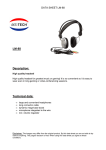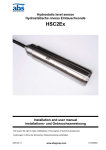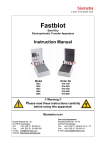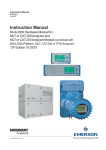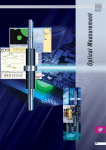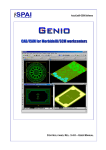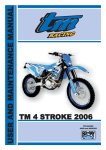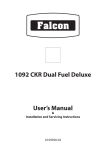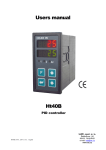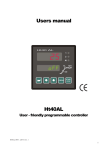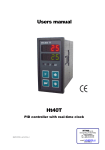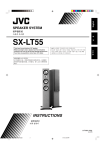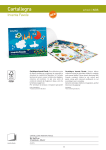Download flatbed modular - electrophoresis-development
Transcript
flatbed modular v20-10/14 Manual flatbed modular Scope of Delivery 1 basic unit including cooling plate and 2 electrode bars - built in a draw 2 movable platinum electrodes 1 hinged safety lid 1 heavy weight glasplate 1 pair of connecting cables for power supplies (2 mm —> 2 mm connectors) 2 x 3 m cooling tube 1 additional internal pump (7.5 V, incl. 220 V adapter) 1 manual Additionally available „Tube Connecting Kit“.for adding three more modular units EDC Electrophoresis Development & Consulting, Vor dem Kreuzberg 17, 72070 Tuebingen (Germany) 1 Content 1. 2. 3. 4. 5. 6. 7. 8. 9. Introduction General Information Technical Data Scope of Delivery Installation of the Appliance Working with the Modular Chamber Connecting the Chamber to a Kryostat Connecting Additional Modular Unit Warranty Page Page Page Page Page Page Page Page Page 2 3 5 5 6 7 9 10 11 „flatbed modular“ with draw pulled out. 1. Introduction Before bringing the appliance into service please read this manual carefully. You will obtain important hints concerning safety and accurate use of the appliance. User’s Commitment Persons working with the appliance are committed to read these instructions and to get themselves informed about the valid measures of accident prevention. Correctness of functioning of the appliance must be checked in regular intervals by the user. Safety Requirements This appliance is run with high voltage up to 6.000 Volts e.g. when isoelectric focussing is performed. The electrophoresis chamber may be run on even and stable lab benches only which have to be free of vibration. Only power supply is allowed to be used the voltage sockets of which are separated galvanicly fom the 230V/50Hz mains. Thus only there is not any electric potential between the plus pole and the earth and between the minus pole and the earth. The electric potential now occurs between plus pole and minus pole only. Please note the user’s manual of your power pack. EDC Electrophoresis Development & Consulting, Vor dem Kreuzberg 17, 72070 Tuebingen (Germany) 2 While high voltage is connected to the appliance no one is permitted to come into contact inside the electrophoresis chamber. Before touching the electrophoresis chamber check that the appliance is separated from power supply. To do this the power supply is switched off and the leads for the plus pole and the minus pole are separated from power supply. The appliance and the power supply cables should be inspected for damage regularly. The appliance is permitted to be used solely to the purpose described herein. 2. General Information The „flatbed modular“ electrophoresis chamber is designed for horizontal electrophoresis and isoelectric focusing in polyacrylamide- and agarose flat-bed gels. For better operation during entire electrophoresis and subsequent visualization procedure these gels should be supported by backing films. The chamber offers best possible protection against electric tension up to 3.000 volt DC. Best operation is obtained when using our instructions concerning the different methods of electrophoresis. The methods can be downloaded from our website or you may wish to order directly: http://www.electrophoresis-development-consulting.de, rubric “Applications”. Initial attempts on horizontal electrophoresis should be executed by using ready-made gels and buffers. The chamber is not constructed for performing electrophoresis out of buffer tanks. The arrangement of strips, gels and electrodes on the „flatbed modular“ chamber should be implemented according to our protocols: Strips of electrode-cardboards EDC Electrophoresis Development & Consulting, Vor dem Kreuzberg 17, 72070 Tuebingen (Germany) 3 drenched with concentrated solutions of electrode buffers are placed at the cathodic and anodic ends of the gels. The Draw The cooling plate is built straight into the basic unit. The surface is made of pure aluminiumoxide ceramics which guarantees best possible and even cooling of put on gels. The material excellently removes the heat produced in the gels under watt-strong running conditions. The thickness of 4 mm guarantees good balance of temperature between adjacent zones. The cooling plate measures are 270 mm x 212 mm which allows to work with all common sizes of finished gels. This cooling is mounted on a draw, so that it can be inserted during run. So the modular tower for multiple electrophoresis can be built. The Electrodes The electrodes delivered along with this system are made of platinum. They were clipped to the electrode bars according to their colours, freely movable and very easily adjustable to any position of gels on the cooling plate. The electrode contact is best possible as the pressure of contact is being generated by the heavy weight glasplate. Retension of the platinum wires: pull them tight again by slowly turning in the two cross-head screws beside the 45° millings. EDC Electrophoresis Development & Consulting, Vor dem Kreuzberg 17, 72070 Tuebingen (Germany) 4 The Safety Lid The new design of the safety lid made of PET & PVC offers active protection against disruptive discharge. Without the lid being shut correctly, high voltage can not reach the cooling plate inside the chamber and therewith the electrode stripes or the gel. Because of this special hinged construction it is not possible to fit the lid into incorrect position nor to confuse the electric poles of the chamber. Insulation between the parts leading high voltage and liable to be touched is dimensioned generously which is necessary for safe work at high voltage up to 3.000 V. 3. Technical Data name of appliance: EDC „flatbed modular“ electrophoresis chamber order number: FB-4856 designed and developed: EDC GbR, Tuebingen (Germany) maximum voltage: 3000 Volt DC working temparature: +5°C bis +40°C material of basic unit: PVC material of of the lid: PET & PVC material of the electrodes: Platinum material and dimensions of cooling plate: Aluminiumoxide ceramics, 270 mm x 212 mm heigth: 125 mm depth: 480 mm width: 590 mm 4. Scope of Delivery One „flatbed modular“ chamber consists of 1 cooling plate with 2 electrode bars on a draw, 1 hinged safety lid, 2 platinum electrodes, a heavy weight glasplate and 1 pair of connecting cables for power supply (2 mm connectors), 2 x 3 m cooling tubing, 1 manual. EDC Electrophoresis Development & Consulting, Vor dem Kreuzberg 17, 72070 Tuebingen (Germany) 5 5. Installation of the Appliance A) Position the „flatbed modular“ chamber on an even lab bench only and close to the power supplier. Use exclusively the cables enclosed for the unit. B) Connect the two cooling connectors with a kyrostat using two silicone hoses. Note that inlet and outlet are not to be confused. The cross-section of the inlet is narrowed. If necessary check the kryostat for position of inlet and outlet. Do not use tap water. The water pressure will destroy the cooling plate. Start the kryostat. (In case of more than 2 modules to be cooled by one kryostat, switch on the additional internal pump(s) after pumping through the cooling fluid several minutes (until no bubbles occur in the outlet tubing) without running them. C) Connect the modular chamber with the turned-off power pack. Do not turn on the power pack yet D) Pull the draw out of the modular chamber until you reach the final outer position E) Arrange the gel and the electrode strips (in case of electrophoresis) on the open cooling plate‘s surface according to its manufacturer‘s manual. F) Clip the elctrodes according to their colour on their electrode bars. The electrodes are freely movable. The electrodes must be moved to the utmost end of the IEF-gels. In the case of electrophoresis gels, move them to the utmost end of the paper electrode strips. G) Then clap the safety lid on top of the basic unit. H) Inserting the draw till its inner final position. Only at this point the draw will be later connected to the high voltage! Now the electric contacts are closed and the power pack can be connected to the „flatbed modular“ chamber. EDC Electrophoresis Development & Consulting, Vor dem Kreuzberg 17, 72070 Tuebingen (Germany) 6 J) Switch on the Kryostate and pump through the moduls until no bubbles will appear in the outlet tubings. Then additionally switch on the additional electric pumps. K) Start electrophoresis now! L) The green LED light on the right side will glow when the current is over 5 mA. The green LED indicates that there is current flowing through the modul (>5mA) L) Opening the safety lid Switch off the power pack or at least turn to “Pause” position. Not any voltage whatsoever must be applied to the safety lid when it is opened! Slide out the draw. The safety lid is now separated electrically from the power pack. Lift lid at its upper plate. 6. Working with the Electrophoresis Chamber Isoelectric Focusing (IEF) Make sure that the power supply is switched off. Apply 2,5 ml kerosene to the cooling plate. Put the IEF gel on to the kerosene support film downward. Avoid air bubbles. Remove exceed kerosene with a cosmetic paper. Line up the gel symmetrically in both directions on the cooling plate. Apply the samples to small pieces of cotton tissue or use a IEF-gel on the cooling plate EDC Electrophoresis Development & Consulting, Vor dem Kreuzberg 17, 72070 Tuebingen (Germany) 7 “Sample Application Strip“ (GE). Now do not lower the safety lid straight onto the gel but leave it in preliminary electrode adjustment. Thus the free movable electrodes can be adjusted to their exact position at the ends of the gels. After that lower the lid to contact position. Set the valid running conditions in the power supply and switch on. Electrophoresis (SDS, native, DNA) Make sure that the power supply is switched off. Apply 2,5 ml kerosene to the cooling plate. Put the electrophoresis gel onto the kerosene support film downward. Avoid air bubbles. Remove exceed kerosene with a cosmetic paper. Line up the gel symmetrically in both directions on the cooling plate. Put the cathodic and the anodic electrode strip on the gel with an overlapping zone of 1 to 2 mm. Remove possibly caught air bubbles by sliding a rounded tweezers’ tip across the overlap zone. Pipette the samples into the Electrophoresis gel and electrode strips on the cooling plate EDC Electrophoresis Development & Consulting, Vor dem Kreuzberg 17, 72070 Tuebingen (Germany) 8 sample slots of the gels. Now do not lower the lid straight onto the electrode strips but leave it in preliminary electrode adjustment. Thus the free movable electrodes can be adjusted to their exact position at the ends of the electrode strips. Thereafter lower the lid to contact position. Set the valid running conditions to the power supply and switch on. 7. Connecting the modular Chamber to a Kryostat A) Main Cooling For tempering of the cooling plate the modular chamber must get connected to a customary kryostat. Caution: Connecting „flatbed modular“ chamber to a tap water pipe will destroy the cooling plate. The water pressure of tap water pipes is too high! Connect the kryostat via the inlet and the outlet at the right lateral side, see illustration below), so that the kryostat can pump the tempering fluid (distilled water is best). Pay attention to the pumping direction of the tempering fluid. The inlet notch is the lower pipe marked with „IN“, the cooling outlet is above the inlet pipe B) Additional Internal Cooling-Pump Please note: If more than 2 modules should be cooled with one kryostate, then the additional internal pump(s) should be switched on: Switch on the additional pumps only after pumping through the main cooling unless there are no bubbles anymore flowing through the outlet tubings. Cooling notches “In“ and „Out“ EDC Electrophoresis Development & Consulting, Vor dem Kreuzberg 17, 72070 Tuebingen (Germany) 9 8. Connecting an additional modular unit to the chamber The additional tools can be ordered as described on page #1: „Tube Connecting Kit“, see left picture. The modules will be connected by a U-shaped tubing: Plug in this connector in the lowest module‘s outlet and the other end to the inlet of the next upper module, see illustration page 11. The cooling outlet of the last module in the cooling chain should lead back to the kryostate‘s inlet. Do not mix-up the inlets and outlets of the moduls and the kryostate! The modular tower tower‘s general outlet: going to the „inlet“ of the cooler! U-shaped „tubing connector“ Tower‘s general cooling inlet: coming from the „outlet“ of the cooler! 9. Warranty In the case of adequate treatment a guarantee period of 24 months applies to this equipment. EDC Electrophoresis Development & Consulting, Vor dem Kreuzberg 17, 72070 Tuebingen (Germany) 10










